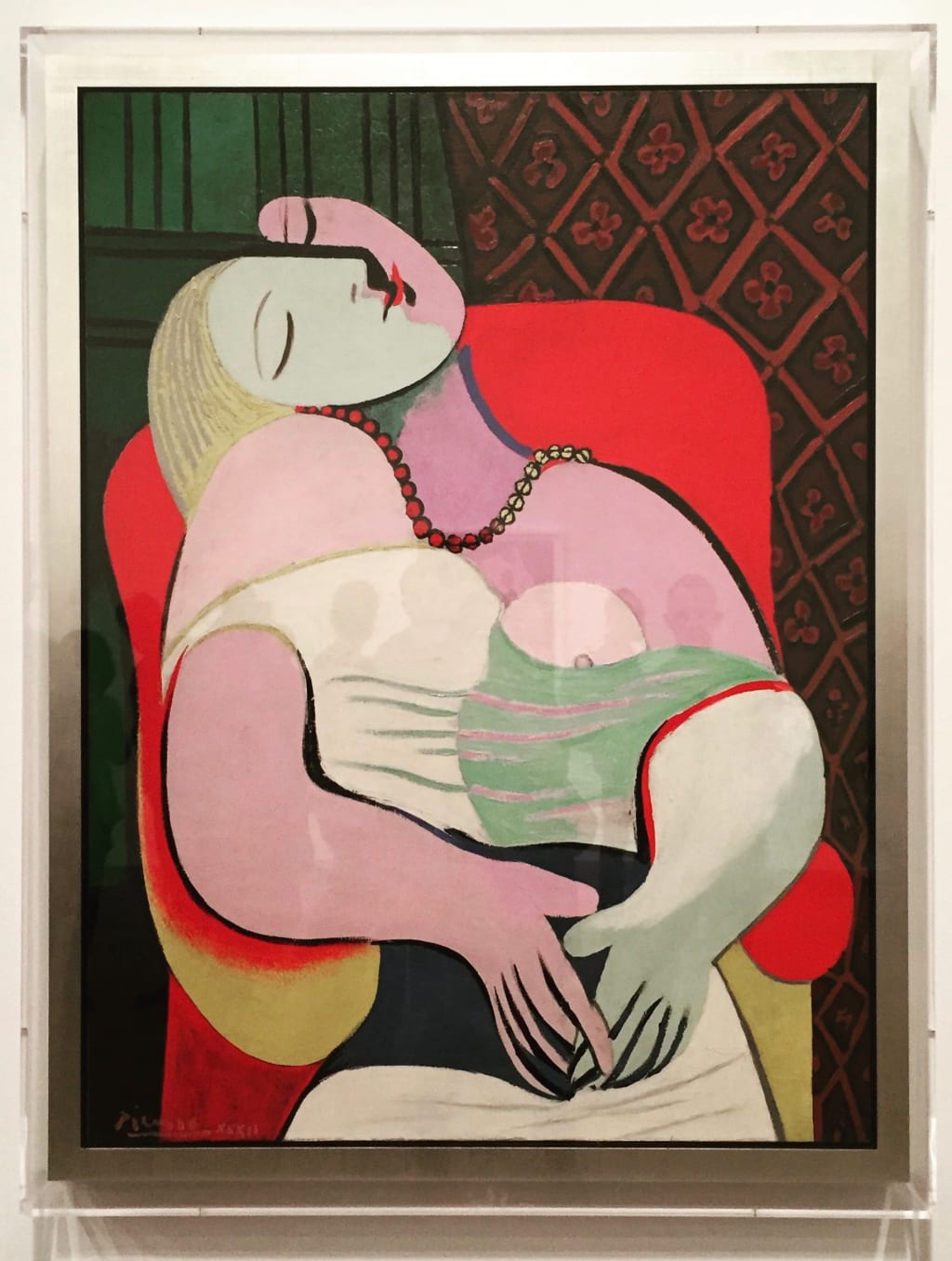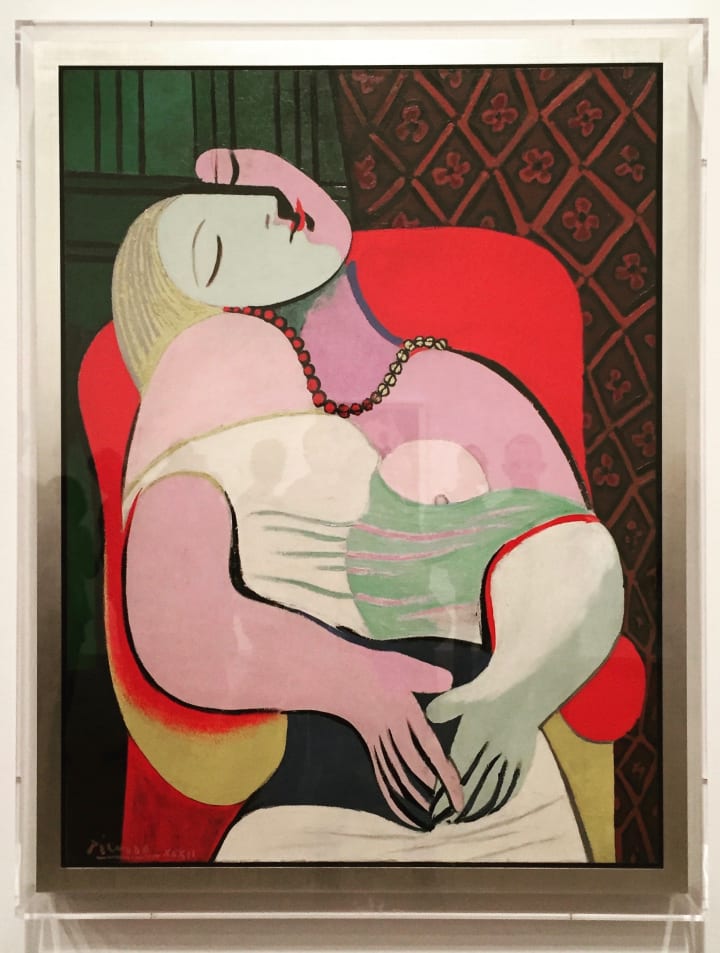What Art Can Teach Us About Love
Lessons From Pablo Picasso

A few weeks ago I went on a first date to the Tate Modern where I, unexpectedly, ended up seeing the Picasso: Love, Fame, and Tragedy exhibition. I will admit to having very few preconceptions: I like art but I am in no way an expert, and I have been underwhelmed by both dates and art (Water Lilies, anyone?) on too many separate occasions. This time, though, I was pleasantly surprised on both fronts.
The exhibit displayed Picasso’s works from one year of his life: 1932. A year in which he was embroiled in a passionate affair that inspired much of his work. As we wandered around, taking in and talking about the paintings – many of which depicted a single female in various poses and states of undress – I couldn’t help being swept up in the romance of it all. The impact of Marie-Therese Walter, Picasso’s mistress, was undeniable, and I found myself thinking about his wife, Olga, and how she felt when she saw his art. This, of course, hit a nerve given everything with C. It felt highly relevant and tugged at my emotions throughout; I am always amazed at how the universe provides mirrors when I am least expecting them.
The opening plinth described the “poles” occupied for Picasso by his mistress and his marriage. The opening text detailed the ‘strained marital relations,’ with Olga, that he felt the ‘need’ to escape. It closed on an even more melancholy note: a somewhat sympathetic analysis of Picasso as a man who ‘felt doomed to cause women to suffer,’ a clear theme in many of his darker pieces that depict depraved acts of sexual violence towards women. A theme that becomes clearer still when delving further into his love affairs – both with his wife and the seven lovers he pursued over the course of his life.
This point of view was as sympathetic as this article – a no holds barred account of Picasso’s misogyny – is scathing, criticising objective viewings of his work that keep it separate from the artist himself.
Having not studied art and not thought about how to view it before, I find it hard to sit on either side of the fence completely; I feel like both are somewhat over-simplified. Picasso may have been a woman eater, “submit[ting] them to his animal sexuality… and crush[ing] them onto his canvas,” just as much as he lamented his destiny to cause them pain. Often when we look back at historical figures, we can forget that they are individuals with rich and complex inner worlds navigating their ways through a society unknown to us. As with any single person, it is difficult to ever really unravel all the personal and sociological subtleties to truly understand them and their behaviours or what they truly meant.

Photo credit: Kink and Cuddles
And let’s not forget that 1932 is a snapshot into Picasso’s side of the story. I can’t comment on his body of work as a whole, but I can comment on what I saw from this 12 month span of his life. We are seeing his wife, his lover, his world, through his mind’s eye as it was then; in the words of Milan Kundera, “The view changes with each step.”
In spite of knowing that I was seeing her through Picasso’s paintbrush, when I saw ‘The Dream,’ I put myself inside Marie-Therese’s head. It resonated with me so deeply.

Photo credit: Kink and Cuddles
The position of her body, reclining so peacefully in the armchair. The softness of the shapes. The uncovered breast. Her fingers lying provocatively on her crotch. And her face… Eyes closed, the blissful – inevitably post-coital – smile playing on her lips. But it’s the split that runs down the length of her body that gets me in this and many of Picasso’s other paintings from 1932. A split I can fully identify with; I have always been contrary and contradictory, but recently I find myself in opposition more and more. In opposition to social norms and in opposition to myself.
And Marie-Therese, through Picasso’s eyes, poses a predicament. She is depicted with such love. Yet she is his mistress. Is she deserving of such devotion? Is she not? And I wonder what she would have to say. Because of the affection that she is painted with, it is hard to imagine her as an unwilling participant in the affair; it is hard to picture her as a victim of Picasso’s misogyny. Yet, the reality is that she played a very specific role for him: she was 17 and he 45 when they met. All else aside, the power imbalance there is huge. According to this essay, she was a fairly docile character and, while very much the catalyst for him leaving Olga, he lost interest in her soon after for the very reasons she was appealing to him in the first place. She, on the other hand, was tied to him her whole life, and committed suicide in 1977, four years after his death.
Conversely, if indeed she is not a victim, should I then be judging her? The idea that a woman could possibly be audacious enough to go, eyes-open, into what could have been a fulfilling relationship with a man who is married. The danger here is honesty. The perceived – or real – lack of shame that might be felt. Because it is inherently wrong in the society, we live in to wage war on the sanctity of marriage.
Here, my mind turns to Anais Nin: famously a mistress to Henry Miller, Nin wrote candidly about her own sex life, including documenting her experiences of incest with her father. She also pushed boundaries with her fictional works, writing about subjects that are so taboo (namely paedophilia) that they invite unconscious judgement. As a result she has been largely discredited both as a writer and as a woman, having been called all the derogatory names a patriarchal society can think of to degrade a sexually free-thinking woman. But, as Ruth Charnock suggests, perhaps it is our own discomfort – even disgust – that enables us to disparage Nin so easily. Perhaps, instead, we should be asking ourselves what we can learn from such candour.
So perhaps the issue is not the art itself, but the way it is perceived through the sociological lens we are conditioned to see through. Should we be sympathetic to Picasso for the internal struggles he seemed to have or scathing of his artwork because of his treatment of the women in his life? Should Anais Nin lose all credibility as a woman and an author because of the choices she made and the things she wrote about? Or, instead, should these things be acknowledged and the art viewed through an lens of understanding?
Because, in my humble opinion both Picasso’s art and Nin’s writing are fundamentally very beautiful. They are also uncomfortable. Knowing I was viewing pictures of Picasso’s mistress definitely had an impact on my thoughts about his work. And when reading Delta of Venus, specifically the parts that describe paedophilia, I had to confront feelings of discomfort but will admit to being intrigued also – where else can we experience this safely but in a fictional world? Are these pieces of art not telling of the human condition? Without such internal conflicts and external behaviours, would their work be anywhere near as compelling? Isn’t the very fact that we’re so afraid to acknowledge and accept them for what they are even more telling?
So, in the end, I think I’ve made up my mind. It sounds almost obvious now, but I do believe that Picasso’s works should be viewed taking his actions into account. We should absolutely not remove the artist from his works; we should view them knowing how he treated the women in his life. However, I don’t believe we should view them more harshly because of the way he behaved: we should view them knowing the inner turmoil he experienced around this and see what we can learn. As humans, we are so accustomed to turning away from difficult feelings. What magic could happen if, instead of turning away from these feelings, we sat with the discomfort and explored it.
Last year, I learned about ‘social constructivism‘ in the context of working with children; turns out it’s useful when viewing art too. Nothing stands alone; everything and everyone has a social context into which they fit. If we don’t take that context into account we learn very little but it’s what we do with that understanding that counts.
And, as seems to be the way at the moment, this one afternoon, spent with S at the Tate, has taught me something new. It has sparked off in me a new appreciation of art and a whole new way of viewing it. As for S; our date turned into a wonderful second and we have a third planned next week. I am very much looking forward to seeing what develops.

Photo credit: Kink and Cuddles
About the Creator
Eleni Peitho
Eleni Peitho is a pseudonym. Exploring my wild side & pushing my boundaries... ❤️ Bratty sub / Consent / Cuddles / Ethical kink / Feminism / Nonmonogamy / Respect / Sapiosexual / Sex Ed / Veganism 👠 IG: kink.and.cuddles






Comments
There are no comments for this story
Be the first to respond and start the conversation.